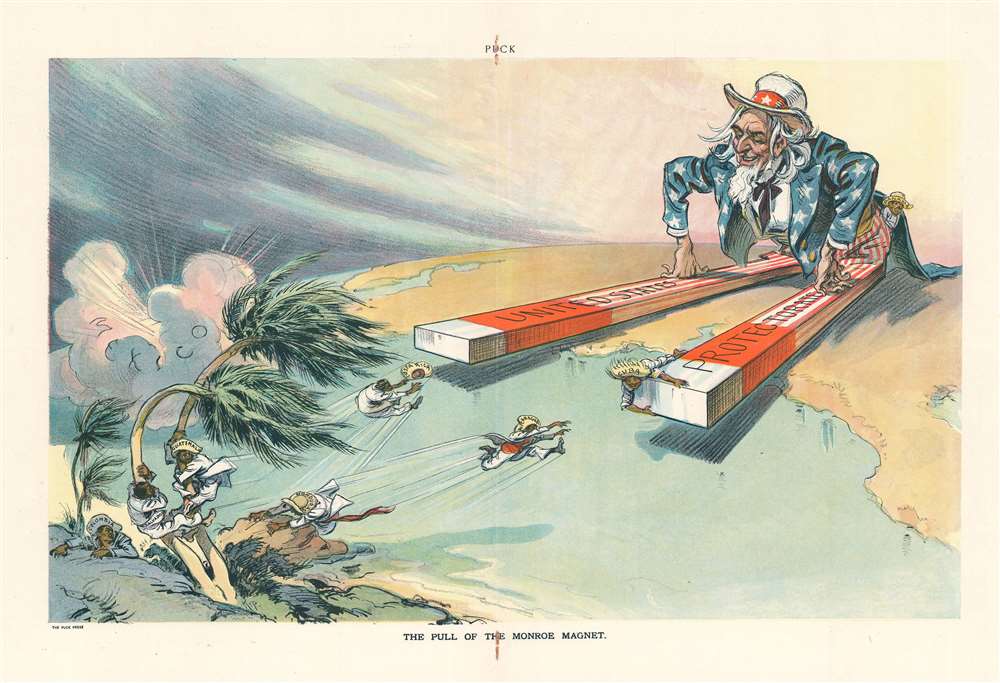This item has been sold, but you can get on the Waitlist to be notified if another example becomes available, or purchase a digital scan.
1913 Puck Magazine Political Cartoon of American Protectorates in Latin America
MonroeMagnet-puck-1913
Title
1913 (undated) 12.5 x 18.5 in (31.75 x 46.99 cm)
Description
U.S. Protectorates in the Caribbean, Central, and South America Before World War I
The first U.S. protectorate in the Caribbean was Cuba, established by the Platt Amendment, which was passed in 1901 and was incorporated into a treaty with Cuba in 1903. The U.S. also established a protectorate over Panama in 1903, after supporting a group seeking independence from Colombia. U.S. support soon won the Americans possession of the Canal Zone from Panama, which the U.S. held sole possession of until 1977. The Theodore Roosevelt administration tried to establish a protectorate in the Dominican Republic but failed to garner Senate support. President Taft's administration then made Nicaragua a protectorate in 1907. All this American interventionism was based on the Monroe Doctrine, which warned European nations against establishing colonies or other puppet governments in the Western Hemisphere. Theodore Roosevelt established the 'Roosevelt Corollary' in 1904, which stated that the U.S. had the right to intervene in any Latin American conflict that exhibited 'flagrant and chronic wrongdoing by the Latin American country.'Chromolithography
Chromolithography is a color lithographic technique developed in the mid-19th century. The process involved using multiple lithographic stones, one for each color, to yield a rich composite effect. Oftentimes, the process would start with a black basecoat upon which subsequent colors were layered. Some chromolithographs used 30 or more separate lithographic stones to achieve the desired effect. Chromolithograph color could also be effectively blended for even more dramatic results. The process became extremely popular in the late 19th and early 20th centuries, when it emerged as the dominate method of color printing. The vivid color chromolithography produced made it exceptionally effective for advertising and propaganda imagery.Publication History and Census
This cartoon was drawn by Udo Keppler and published in the August 13, 1913 issue of Puck. One example is cataloged in OCLC, and it is part of the collection at the Library of Congress.Cartographer
Udo J. Keppler (April 4, 1872 - July 4, 1956) was an American political cartoonist, Native American advocate, and publisher, known as Joseph Keppler Jr. beginning in 1894. The son of Joseph Keppler (1838 - 1894), the founder of Puck magazine, he was born in St. Louis, Missouri, and graduated from the Columbia Institute in 1888. Between 1890 and 1891, Keppler studied in Germany, and worked for Puck from 1890 until 1914. He contributed cartoons to the magazine beginning that year and became a co-owner of the magazine after his father's death in 1894. He changed his name to Joseph Keppler Jr. after he inherited his father's position at the magazine. He sold Puck in December 1913, and stayed on as art director for another four months. After the sale of Puck, Keppler contributed to Judge and Leslie's Weekly until 1915, and retired in 1920. He moved to La Jolla, California, in 1946 where he died ten years later. He married Louise (Lulu) Eva Bechtel, a match opposed by his mother and sister, on April 4, 1895. More by this mapmaker...

